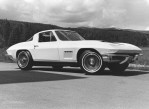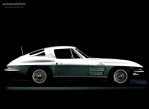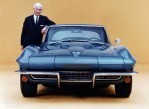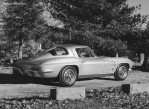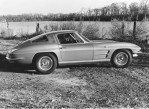Body style: Coupé (two-door)
Segment: Coupe
Production years: 1962, 1963, 1964, 1965, 1966, 1967
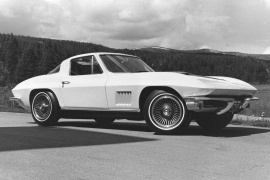 6 Photos
6 PhotosIn 1962, Chevrolet started production for the 1963 model year Corvette, and the car was a huge leap above its predecessors thanks to clever engineering and improved car design methods.
While the C1 Corvette was phasing out, Zora Arkus-Duntov and the design team started to work on the C2 in 1960. Unlike the first generation, which was mostly a concept car that evolved into a production model but was not thoroughly developed, the C2 was a different story. Duntov was focused on the car’s balance and suspension, while the main designer, Larry Shinoda, used the wind tunnel to shape the bodywork. Moreover, the car was available as a coupe, unlike the C1, which was offered only as a roadster, with a split window in the back and a nameplate that would live decades to come: the Sting Ray. Yes, it was with two words for the C2.
It was a revolutionary design concept, and that could be seen at the front where Larry Shinoda installed pop-up headlights. This styling idea lived on the Corvette until the 2005 C6. Still, the car retained the twin round headlamps inherited from the 1968 ‘Vette. A slim and broad grille was placed lower, behind the chromed bumpers that resembled those installed on the ’68 Corvette. Another impressive styling element for those times was the taller front fenders.
From its profile, the Corvette Sting Ray showed a raked windshield followed by a short roof and a sloped, boat-tail-like rear end. Duntov didn’t like the split window idea since the vertical slat obstructed the rearview, but Harley Earl and the rest of the team loved it. On the front fenders, the C2 featured exhaust vents, while the rear quarter sported eyebrow-like bulges above the wheel wells. Finally, at the back, below the glass area, Chevrolet installed the fuel-filler cap adorned by a chromed Corvette-specific badge with two flags. The C2 continued the twin-round taillights that were introduced on the 1961 Corvette.
Thanks to the transaxle system adopted by the Corvette, the cabin was roomier than on its predecessor, while the twin-cowl design dashboard featured a more generous glove box in front of the side passenger. Chevrolet installed a new instrument cluster in front of the driver, featuring large dials for the tachometer and speedometer and four additional gauges that flanked them. The center stack housed the radio, the heather’s controls, and a clock, while a narrow console for the transmission tunnel was between the seats. In the back, Chevrolet installed a small shelf since there was no external trunk.
But the most significant upgrades happened under the car’s skin. During 1953 and 1960, the fiberglass technology evolved, and GM could create thinner body panels than on the original Corvette. In addition, since the Sting Ray was a coupe, it was lighter than the open-top C1. Duntov, obsessed with weight distribution, created a transaxle system, which sent the gearbox in the back. He also created an independent rear suspension. Under the hood, the C2 was available exclusively with V8 engines fed either by Rochester fuel injection systems or by four-barrel carburetors. GM offered the Sting Ray a standard four-speed manual with an option for a two-speed automatic.
CHEVROLET Corvette C2 Sting Ray Coupe 1962, 1963, 1964, 1965, 1966, 1967
- 5.4L V8 3MT (304 HP)
CHEVROLET Corvette C2 Sting Ray Coupe
5.4L V8 3MT (304 HP)
ENGINE SPECS - 5.4L V8 3MT (304 HP) | |
|---|---|
| Cylinders: | V8 |
| Displacement: | 5356 cm3 |
| Power: | 224 KW @ 5000 RPM 304 HP @ 5000 RPM 300 BHP @ 5000 RPM |
| Torque: | 360 lb-ft @ 3200 RPM 488 Nm @ 3200 RPM |
| Fuel System: | Carburetor |
| Fuel: | Gasoline |
PERFORMANCE SPECS | |
|---|---|
| Top Speed: | 147 mph (237 km/h) |
TRANSMISSION SPECS | |
|---|---|
| Drive Type: | Rear Wheel Drive |
| Gearbox: | 3-speed manual |
BRAKES SPECS | |
|---|---|
| Front: | Drums |
| Rear: | Drums |
DIMENSIONS | |
|---|---|
| Length: | 175.3 in (4453 mm) |
| Width: | 69.7 in (1770 mm) |
| Height: | 50.2 in (1275 mm) |
| Front/rear Track: | 56.5/57.2 in (1,435/1,453 mm) |
| Wheelbase: | 98 in (2489 mm) |
WEIGHT SPECS | |
|---|---|
| Unladen Weight: | 3137.2 lbs (1423 kg) |
